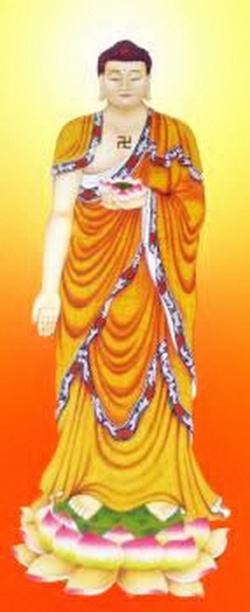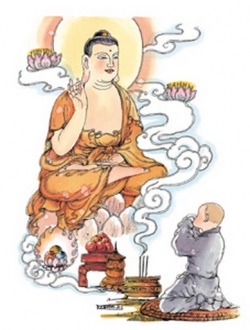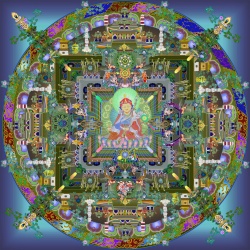Difference between revisions of "The Dharma Flower Sutra seen through the Oral Transmission of Nichiren Daishōnin: The Twenty-second Chapter on the Assignment of the Mission"
m (Text replacement - "]]]" to "]])") |
|||
| Line 29: | Line 29: | ||
The second important point, on the above sentence in the [[sutric]] text, “The [[Tathāgata]] is the [[universal]] [[lord]] of benefaction for all [[sentient beings]].” | The second important point, on the above sentence in the [[sutric]] text, “The [[Tathāgata]] is the [[universal]] [[lord]] of benefaction for all [[sentient beings]].” | ||
| − | The [[Oral Transmission]] on the Meaning of the [[Dharma Flower Sutra]] ([[Ongi Kuden]]) states that since the [[Tathāgata]] is the [[Tathāgata]] of the inexplicably imponderable quality of the [[Dharma]] of the original {{Wiki|archetypal}} state [which is [[life]] as an [[essential]] ingredient of [[existence]] | + | The [[Oral Transmission]] on the Meaning of the [[Dharma Flower Sutra]] ([[Ongi Kuden]]) states that since the [[Tathāgata]] is the [[Tathāgata]] of the inexplicably imponderable quality of the [[Dharma]] of the original {{Wiki|archetypal}} state [which is [[life]] as an [[essential]] ingredient of [[existence]]), in this case, the title [[Tathāgata]] implies the [[practitioner]] of the [[Dharma Flower Sutra]] ([[Hokke-kyō]]) who is here {{Wiki|present}}. The expression “the [[universal]] [[lord]] of benefaction” refers to the diffusion of the title and theme ([[daimoku]]) of [[Nam Myōhō Renge Kyō]], which means to devote our [[lives]] to and found them on (Nam[u]) the Utterness of the [[Dharma]] ([[Myōhō]]) [entirety of [[existence]]) permeated by the underlying [[white lotus]] flower-like {{Wiki|mechanism}} of the [[interdependence]] of [[cause]], concomitancy and effect ([[Renge]]) in its whereabouts of the ten ([[psychological]]) [[realms]] of [[dharmas]] ([[Kyō]]), during this {{Wiki|present}} [[time]] that is the final period of the [[Dharma]] of [[Shākyamuni]]. |
The [[word]] “[[lord]]” should be understood as the [[Bodhisattva]] {{Wiki|Superior}} Practice (Jōgyō, Vishishtachāritra) [with whom [[Nichiren]] identifies himself]. However, this chapter tends to refer to events that are derived from the result of [[Shākyamuni]] [[Buddha’s]] [[life]] and work (shakumon) and is the description of the assignment of the [[mission]] to the [[Bodhisattva]] {{Wiki|Superior}} Practice (Jōgyō, Vishishtachāritra). Because this [[bodhisattva]] was the leader of the [[bodhisattvas]] who swarmed up out of the [[earth]], the fundamental significance of the [[Bodhisattva]] {{Wiki|Superior}} Practice (Jōgyō, Vishishtachāritra) is quite apparent. | The [[word]] “[[lord]]” should be understood as the [[Bodhisattva]] {{Wiki|Superior}} Practice (Jōgyō, Vishishtachāritra) [with whom [[Nichiren]] identifies himself]. However, this chapter tends to refer to events that are derived from the result of [[Shākyamuni]] [[Buddha’s]] [[life]] and work (shakumon) and is the description of the assignment of the [[mission]] to the [[Bodhisattva]] {{Wiki|Superior}} Practice (Jōgyō, Vishishtachāritra). Because this [[bodhisattva]] was the leader of the [[bodhisattvas]] who swarmed up out of the [[earth]], the fundamental significance of the [[Bodhisattva]] {{Wiki|Superior}} Practice (Jōgyō, Vishishtachāritra) is quite apparent. | ||
| Line 53: | Line 53: | ||
Then [[Shākyamuni]] [[Buddha]] made all his [[Buddha]] [[emanations]] from the [[ten directions]] return to their respective existential {{Wiki|dimensions}} and said the following words: “May each of the [[Buddhas]] go in [[peace]]. May the [[stupa]] of Abundant [[Treasure]] (Tahō) return to where it came from.” | Then [[Shākyamuni]] [[Buddha]] made all his [[Buddha]] [[emanations]] from the [[ten directions]] return to their respective existential {{Wiki|dimensions}} and said the following words: “May each of the [[Buddhas]] go in [[peace]]. May the [[stupa]] of Abundant [[Treasure]] (Tahō) return to where it came from.” | ||
| − | When the [[Buddha]] had pronounced these words, all the [[Buddhas of the ten directions]] who were seated under [[trees]] of [[precious]] materials on their [[lion]] thrones, as well as the [[Buddha]] Abundant [[Treasure]] (Tahō [[Butsu]]) along with the [[Bodhisattva]] {{Wiki|Superior}} Practice (Jōgyō, Vishishtachāritra) and the assembly of boundlessly numberless [[bodhisattvas]], Sharihotsu ([[Shariputra]]), and the assembly of [[monks]], [[nuns]], and {{Wiki|male}} and {{Wiki|female}} lay practitioners, as well as the [[people]] who exerted themselves to attain the [[highest]] stage of the [[individual vehicle]] (shōjō, [[hīnayāna]]) through listening to the [[Buddha]], furthermore (shōmon, shrāvaka), all the [[deva]] (ten) of every existential [[space]] [who were similar to the [[gods]] in either Mediterranean or {{Wiki|Teutonic}} [[mythology]] and who lived above the [[earth]] in the [[heavens]] and had long and ecstatic [[lives]] | + | When the [[Buddha]] had pronounced these words, all the [[Buddhas of the ten directions]] who were seated under [[trees]] of [[precious]] materials on their [[lion]] thrones, as well as the [[Buddha]] Abundant [[Treasure]] (Tahō [[Butsu]]) along with the [[Bodhisattva]] {{Wiki|Superior}} Practice (Jōgyō, Vishishtachāritra) and the assembly of boundlessly numberless [[bodhisattvas]], Sharihotsu ([[Shariputra]]), and the assembly of [[monks]], [[nuns]], and {{Wiki|male}} and {{Wiki|female}} lay practitioners, as well as the [[people]] who exerted themselves to attain the [[highest]] stage of the [[individual vehicle]] (shōjō, [[hīnayāna]]) through listening to the [[Buddha]], furthermore (shōmon, shrāvaka), all the [[deva]] (ten) of every existential [[space]] [who were similar to the [[gods]] in either Mediterranean or {{Wiki|Teutonic}} [[mythology]] and who lived above the [[earth]] in the [[heavens]] and had long and ecstatic [[lives]]), and the [[shura]] ([[ashura]]) [who were like the titans in Mediterranean [[mythology]] or the giants and ogres in Northern {{Wiki|European}} {{Wiki|folklore}}], were all filled with [[joy]] through having listened to the [[Buddha]]. |
{{DharmaFlowerSutraNichiren}} | {{DharmaFlowerSutraNichiren}} | ||
Latest revision as of 03:57, 5 April 2016
The Dharma Flower Sutra
seen through the Oral Transmission of
Nichiren Daishōnin
At that time, Shākyamuni Buddha got up from his Dharma seat . . . .
The first important point, on the opening phrase of the above sutric text, “At that time, Shākyamuni Buddha got up from his Dharma seat . . . .”
The Oral Transmission on the Meaning of the Dharma Flower Sutra (Ongi Kuden) makes it clear that Shākyamuni Buddha got up from where he was sitting in the stupa made of precious materials, in order to conduct the ceremony outside the stupa. This was the ceremony of the assignment of the mission, transferring the responsibility for the propagation of this teaching, by caressing three times the heads of the bodhisattvas – both those who were converted in the original archetypal state, along with those who were converted during the time of the teachings derived from the external events of Buddha Shākyamuni’s life and work – to show that they were attached to this particular teaching. [In China, Tibet, and Korea, the monks of the various schools caress the tops of the heads of disciples and people who ask them questions, as a sign to show that such people are affiliated with the Buddha teaching.]
The three caresses on the tops of the bodhisattvas’ heads signify the three karmas of deed, word, and thought. The three categorical propositions are 1) relativity (kū, shūnyatā) which we ordinary people sense as noumena; this implies that all that exists is causally produced and that its essential nature is immaterial. 2) Even though all that exists is immaterial in its real nature, its manifestations are physical (ke) and conform to the laws of physicality. 3) However, both of these categorical propositions are a single entity (chū), and together they are the suchness of existence (nyo, tathatā). Along with the three insights in which are each instant of mental activity (ichinen sanzen), 1) all existence is immaterial; 2) but its material manifestations are transient or temporal; 3) yet it is the realisation that these truths all occur in our minds at the same instant.
. . . . and manifested the all-embracing reaches of his mind, by caressing with his right hand the tops of the heads of the boundlessly infinite number of completely evolved bodhisattvas who had refused their own extinction into nirvana for the sake of the Buddha enlightenment of all sentient beings (bosatsu makasatsu, bodhisattva mahāsattva).
Then he said to them the following words: “Over a period of hundreds of thousands of myriads of myriads of myriads of kalpas, I have continuously practised and cultivated this difficultly attained, unexcelled, correct, and all-embracing enlightenment (anokutara sanmyaku sambodai, anuttara samyak sambodhi) which I now hand over to you. You must accept it, hold to it, read it and recite it, as well as with all your strength propagate and spread this Dharma abroad, so as to widely increase its benefit.”
Thereupon the Buddha caressed three times the tops of the heads of all the completely evolved bodhisattvas who had refused their own extinction into nirvana for the sake of the Buddha enlightenment of all sentient beings, and said to them again the following words: “Over a period of hundreds of thousands of myriads of myriads of myriads of kalpas, I have continuously practised and cultivated this difficultly attained, unexcelled, correct, and all-embracing enlightenment which I now hand over to you. You must certainly accept it, hold to it, read and recite it, as well as proclaiming it widely, so that sentient beings everywhere will hear of it and get to know it.”
What is the reason for this?
The Tathāgata possesses an all-embracing loving-kindness, without any fear or selfishness whatsoever. He is capable of giving sentient beings the wisdom of the Buddhas, the wisdom of the Tathāgata, along with the wisdom that exists all on its own. The Tathāgata is the universal lord of benefaction for all sentient beings.
The second important point, on the above sentence in the sutric text, “The Tathāgata is the universal lord of benefaction for all sentient beings.”
The Oral Transmission on the Meaning of the Dharma Flower Sutra (Ongi Kuden) states that since the Tathāgata is the Tathāgata of the inexplicably imponderable quality of the Dharma of the original archetypal state [which is life as an essential ingredient of existence), in this case, the title Tathāgata implies the practitioner of the Dharma Flower Sutra (Hokke-kyō) who is here present. The expression “the universal lord of benefaction” refers to the diffusion of the title and theme (daimoku) of Nam Myōhō Renge Kyō, which means to devote our lives to and found them on (Nam[u]) the Utterness of the Dharma (Myōhō) [entirety of existence) permeated by the underlying white lotus flower-like mechanism of the interdependence of cause, concomitancy and effect (Renge) in its whereabouts of the ten (psychological) realms of dharmas (Kyō), during this present time that is the final period of the Dharma of Shākyamuni.
The word “lord” should be understood as the Bodhisattva Superior Practice (Jōgyō, Vishishtachāritra) [with whom Nichiren identifies himself]. However, this chapter tends to refer to events that are derived from the result of Shākyamuni Buddha’s life and work (shakumon) and is the description of the assignment of the mission to the Bodhisattva Superior Practice (Jōgyō, Vishishtachāritra). Because this bodhisattva was the leader of the bodhisattvas who swarmed up out of the earth, the fundamental significance of the Bodhisattva Superior Practice (Jōgyō, Vishishtachāritra) is quite apparent.
Therefore, you must accordingly study the Dharma of the Tathāgata. You must not give way to any selfishness. In future dimensions of existence, if there is any believing and convinced men or women who hold faith in the wisdom of the Tathāgata, you must explain to them this Dharma Flower Sutra (Hokke-kyō), so as to let them hear it and get to know it, so as to allow these people to attain the wisdom of the Tathāgata. If there are sentient beings that will neither accept nor believe in this teaching, then you must show them and teach them the other profound teachings, so that they can benefit from them and find pleasure in them. If you are capable of acting in this manner, it will actually bring about the benefits of all the Buddhas.
Thereupon, when all the completely evolved bodhisattvas who had refused their own extinction into nirvana for the sake of the Buddha enlightenment of all sentient beings (bosatsu makasatsu, bodhisattva mahāsattva) heard the Buddha preach in this way, their whole persons were filled with great joy, and they intensified their veneration for him.
Bowing, with their heads lowered in reverence, with the palms of their hands joined together, and facing the Buddha, they all spoke in unison, saying: “We will do exactly as the World Honoured One directs. Indeed we will carry it all out in detail. Our only wish is that the World Honoured One will have no worries about this matter.
The third important point, on the vow of the bodhisattvas in the sutric text: “We will do exactly as the World Honoured One directs. Indeed we will carry it all out in detail. Our only wish is that the world Honoured One will have no worries about this matter.”
The Oral Transmission on the Meaning of the Dharma Flower Sutra (Ongi Kuden) states that this passage consists of the vow made by all the bodhisattvas and other beings. It is according to this passage in the sutric test that Nichiren and those that follow him dare to be at variance with the deva (ten) and the bodhisattva spirit of good [such as when Nichiren remonstrated with Hachiman Bosatsu before Tatsu no Kuchi] for not fulfilling his vow to protect the practitioner of the Dharma Flower Sutra (Hokke-kyō).
The whole assembly of the completely evolved bodhisattvas who had refused their own extinction into nirvana for the sake of the Buddha enlightenment of all sentient beings (bosatsu makasatsu, bodhisattva mahāsattva) said all together three times over: “We will do exactly as the World Honoured One directs. Indeed we will carry everything out in detail. Our only wish is that the World Honoured One will have no worries about this matter.”
Then Shākyamuni Buddha made all his Buddha emanations from the ten directions return to their respective existential dimensions and said the following words: “May each of the Buddhas go in peace. May the stupa of Abundant Treasure (Tahō) return to where it came from.”
When the Buddha had pronounced these words, all the Buddhas of the ten directions who were seated under trees of precious materials on their lion thrones, as well as the Buddha Abundant Treasure (Tahō Butsu) along with the Bodhisattva Superior Practice (Jōgyō, Vishishtachāritra) and the assembly of boundlessly numberless bodhisattvas, Sharihotsu (Shariputra), and the assembly of monks, nuns, and male and female lay practitioners, as well as the people who exerted themselves to attain the highest stage of the individual vehicle (shōjō, hīnayāna) through listening to the Buddha, furthermore (shōmon, shrāvaka), all the deva (ten) of every existential space [who were similar to the gods in either Mediterranean or Teutonic mythology and who lived above the earth in the heavens and had long and ecstatic lives), and the shura (ashura) [who were like the titans in Mediterranean mythology or the giants and ogres in Northern European folklore], were all filled with joy through having listened to the Buddha.
Continue Reading
- The Dharma Flower Sutra seen through the Oral Transmission of Nichiren Daishōnin: Preface
- The Dharma Flower Sutra seen through the Oral Transmission of Nichiren Daishōnin: Synopsis of the Dharma Flower Sutra (Hokke-kyō) Trilogy
- The Dharma Flower Sutra seen through the Oral Transmission of Nichiren Daishōnin: The First and Introductory Chapter
- The Dharma Flower Sutra seen through the Oral Transmission of Nichiren Daishōnin: The Second Chapter on Expedient Means
- The Dharma Flower Sutra seen through the Oral Transmission of Nichiren Daishōnin: The Third Chapter on Similes and Parables
- The Dharma Flower Sutra seen through the Oral Transmission of Nichiren Daishōnin: The Fourth Chapter on Faith Leading to Understanding
- The Dharma Flower Sutra seen through the Oral Transmission of Nichiren Daishōnin: The Fifth Chapter on The Parable of the Medicinal Herbs
- The Dharma Flower Sutra seen through the Oral Transmission of Nichiren Daishōnin: The Sixth Chapter on The Disclosure of the Future Record Of those who will attain Enlightenment
- The Dharma Flower Sutra seen through the Oral Transmission of Nichiren Daishōnin: The Seventh Chapter on The Parable of the Imaginary City
- The Dharma Flower Sutra seen through the Oral Transmission of Nichiren Daishōnin: The Eighth Chapter on the Prediction of Enlightenment for Five Hundred Disciples
- The Dharma Flower Sutra seen through the Oral Transmission of Nichiren Daishōnin: The Ninth Chapter on the Announcement of the Future Attainment to Buddhahood of Both Those who Need and Do Not Need Instruction
- The Dharma Flower Sutra seen through the Oral Transmission of Nichiren Daishōnin: The Tenth Chapter on The Dharma as a Teacher
- The Dharma Flower Sutra seen through the Oral Transmission of Nichiren Daishōnin: The Eleventh Chapter on Seeing the Vision of the Stupa made of Precious Materials
- The Dharma Flower Sutra seen through the Oral Transmission of Nichiren Daishōnin:The Twelfth Chapter on Daibadatta (Devadatta)
- The Dharma Flower Sutra seen through the Oral Transmission of Nichiren Daishōnin:The Thirteenth Chapter on Exhorting the Disciples to Receive and Hold to the Buddha Teaching
- The Dharma Flower Sutra seen through the Oral Transmission of Nichiren Daishōnin:The Fourteenth Chapter on Practising in Peace and with Joy
- The Dharma Flower Sutra seen through the Oral Transmission of Nichiren Daishōnin:The Fifteenth Chapter on the Bodhisattvas who Swarm up Out of the Earth
- The Dharma Flower Sutra seen through the Oral Transmission of Nichiren Daishōnin:The Sixteenth Chapter on the Lifespan of the Tathāgata
- The Dharma Flower Sutra seen through the Oral Transmission of Nichiren Daishōnin:The Seventeenth Chapter on Discerning the Meritorious Virtues
- The Dharma Flower Sutra seen through the Oral Transmission of Nichiren Daishōnin:The Eighteenth Chapter on the Joy of the following Meritorious Virtues of Practice
- The Dharma Flower Sutra seen through the Oral Transmission of Nichiren Daishōnin:The Nineteenth Chapter on the Meritorious Virtues of the Teacher who Propagates the Dharma Flower Sutra
- The Dharma Flower Sutra seen through the Oral Transmission of Nichiren Daishōnin: The Twentieth Chapter on the Bodhisattva Not Holding Anyone or Anything in Contempt Ever (Jōfukyō, Sadapāribbhūta)
- The Dharma Flower Sutra seen through the Oral Transmission of Nichiren Daishōnin: The Twenty-first Chapter on the Reaches of the Mind of the Tathāgata
- The Dharma Flower Sutra seen through the Oral Transmission of Nichiren Daishōnin: The Twenty-second Chapter on the Assignment of the Mission
- The Dharma Flower Sutra seen through the Oral Transmission of Nichiren Daishōnin: The Twenty-third Chapter on the Original Conduct of the Bodhisattva Sovereign Medicine (Yaku’ ō, Bhaishajya-rāja)
- The Dharma Flower Sutra seen through the Oral Transmission of Nichiren Daishōnin: The Twenty-fourth Chapter on the Bodhisattva Sound of Utterness (Myo ‘on, Gadgadasvara)
- The Dharma Flower Sutra seen through the Oral Transmission of Nichiren Daishōnin: The Twenty-fifth Chapter on the Universal Gateway of the Bodhisattva Perceiving the Sound of the Existential Dimensions (Kanzeon, Avalokiteshvara)
- The Dharma Flower Sutra seen through the Oral Transmission of Nichiren Daishōnin: The Twenty-sixth Chapter on Dhāranī
- The Dharma Flower Sutra seen through the Oral Transmission of Nichiren Daishōnin: The Twenty-seventh Chapter on the Original Conduct of King Utterly Embellished (Myōshōgonnō, Shubhavyūha)
- The Dharma Flower Sutra seen through the Oral Transmission of Nichiren Daishōnin: The Twenty-eighth Chapter on the Persuasiveness and Quest (for Buddhahood) of the Bodhisattva Universally Worthy (Samantabhadra, Fugen)





